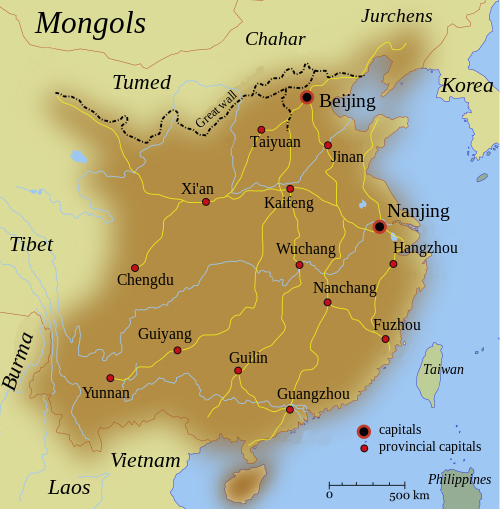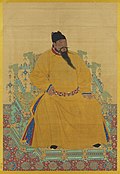Ming dynasty
The Ming dynasty was the family of emperors who led China from AD 1368 to 1644. The name is also used to talk about the Ming Empire that they led and the 276 years in Chinese history that it lasted.
Great Ming 大明 | |||||||||||
|---|---|---|---|---|---|---|---|---|---|---|---|
| 1368–1644 | |||||||||||
 Ming China around 1580 | |||||||||||
| Capital | Nanjing (Yingtian prefecture) (1368–1644)[a] Beijing (Shuntian prefecture) (1403–1644)[b][c] | ||||||||||
| Common languages | Official language: Mandarin Other Chinese languages Other languages: Turki (Modern Uyghur), Old Uyghur language, Tibetan, Mongolian, Jurchen, others | ||||||||||
| Religion | Heaven worship, Taoism, Confucianism, Buddhism, Chinese folk religion, Islam, Roman Catholicism | ||||||||||
| Government | Absolute monarchy | ||||||||||
| Emperor (皇帝) | |||||||||||
• 1368–1398 (first) | Hongwu Emperor | ||||||||||
• 1402–1424 | Yongle Emperor | ||||||||||
• 1521–1567 | Jiajing Emperor | ||||||||||
• 1627–1644 (last) | Chongzhen Emperor | ||||||||||
| Senior Grand Secretary | |||||||||||
• 1402–1407 | Xie Jin | ||||||||||
• 1644 | Wei Zaode | ||||||||||
| History | |||||||||||
• | 23 January 1368 | ||||||||||
• Beijing designated as capital | 28 October 1420 | ||||||||||
• | 25 April 1644 | ||||||||||
• End of the Southern Ming | 1683 | ||||||||||
| Area | |||||||||||
| 1415[1] | 6,500,000 km2 (2,500,000 sq mi) | ||||||||||
| Population | |||||||||||
• 1393 | 65,000,000 | ||||||||||
• 1403 | 66,598,337¹ | ||||||||||
• 1500 | 125,000,000² | ||||||||||
• 1600 | 160,000,000³ | ||||||||||
| Currency | Paper money (1368–1450) Bimetallic: copper cashes (文, wén) in strings of coin and paper Silver taels (兩, liǎng) in sycees and by weight | ||||||||||
| |||||||||||
| Today part of | |||||||||||
Remnants of the Ming dynasty ruled southern China until 1662, and Taiwan until 1683 a dynastic period which is known as the Southern Ming. ¹The numbers are based on estimates made by CJ Peers in Late Imperial Chinese Armies: 1520–1840 ²According to A. G. Frank, ReOrient: global economy in the Asian Age, 1998, p. 109 ³According to A. Maddison, The World Economy Volume 1: A Millennial Perspective Volume 2, 2007, p. 238 | |||||||||||
It is also famous for its pottery from Jingdezhen in Jiangxi and Dehua in Fujian.
Name
The Ming dynasty is known in Chinese as the Míng.[d] This is written as 明 in Chinese characters. The character is a sun (日) and a moon (月) together and means "bright". Chinese uses different words to talk about the different meanings of a Chinese "dynasty" in English: their government is called the Míng cháo (明朝), their country is called the Dà Míng dìguó (大明帝國 or 大明帝国), and their time in Chinese history is called the Míng dài (明代).
Unlike in English, the name of the dynasty is not the same as the family name of the leaders. The family that led China during the Ming were the Zhūs.[d] This is written as 朱 in Chinese characters. Today, it is just a common Chinese family name, but at that time it meant a kind of red coloring made from cinnabar (HgS).
History
The Yuan dynasty before them had been part of the Mongol Empire started by Genghis Khan. The Yuan dynasty was established by Kublai Khan. Its emperors had been Mongolian people, but most of China was Han Chinese. To keep their power, the Yuan used a Chinese kind of government of Three Departments and Six Ministries, with imperial examinations. Their laws gave special powers to Mongolian people, though, with other people from other countries ("Semu") placed second, northern Chinese third, and southern Chinese last. They were especially nice to Tibetan Buddhists and gave many important jobs to Muslims, although they also made Muslims break some rules and eat like Mongolians. Some Muslims were angry and started to fight the Yuan. Many people began to fight after the 1340s. The Black Death killed many people and the government did not keep up the work needed to stop the Yellow River from killing people when it flooded. The Red Turbans began fighting in 1351 and its best leader Zhu Yuanzhang made the Yuan emperor Toghun Temür run away from the capital city Khanbaliq (now inside Beijing) in 1368.
When Zhu Yuanzhang took Khanbaliq, he said that the Yuan was over and that his family would be a new dynasty called the Ming. He said that 1368 was the 1st year of the Hongwu Era and became known as the Hongwu Emperor. Toghun Temür and other Mongolians still fought him, but now they were known as the Northern Yuan and the Ming became the real government of most of China.
The Hongwu Emperor had many sons and made them the leaders of the 13 different parts of China. He did not stay in Khanbaliq. He made his old base Yingtian (today's Nanjing) into the new capital city. He wanted China to be more traditional and more Chinese, so he ended most government support for other religions and made Christianity against the law. He wanted China to take care of itself, so he ended most buying and selling of things from other countries. He made a list of rules for his family, and they mostly followed them during the rest of the Ming.
The oldest son of the Hongwu Emperor died before him, so the next emperor was his grandson the Jianwen Emperor. The Jianwen Emperor was about 20 years old and didn't like the power of his many uncles. He started taking away their power, sending them away, or even making them kill themselves. The uncle leading Beiping (old Khanbaliq and now Beijing) was named Zhu Di. He pretended to be crazy so that the Jianwen Emperor would be less afraid. The emperor even let his three sons—kept in the capital city to be sure of their father's good behavior—go north see him. Zhu Di then began a war against his nephew.
At first, Zhu Di said his war was only against the "bad helpers" who told his nephew to hurt their family. When his war was successful and he took Yingtian (now Nanjing), he made himself the Yongle Emperor. He said that his nephew had never been the real emperor and killed many people in the old government. He did not trust the people in Yingtian, so he made Beiping the main capital city. The southern capital then became known as Nanjing and the northern capital Beijing, the names they continue to use today. In Beijing, he built a new home which became the Forbidden City.
The Yongle Emperor did not like many of the people in government who got there by doing well on their tests. He gave more power to eunuchs, men who were hurt as children to stop them from being able to have children of their own. One of these was Zheng He, a Muslim who led great treasure ships south from Suzhou and Nanjing in 7 big trips between 1405 and 1433. The first trips may have been looking for the Jianwen Emperor, but they also became trips that taught China about the South China Sea and Indian Ocean and opened up more buying and selling between their countries and China.
The Mings' main capital of Beijing fell in 1644 to a rebellion led by Li Zicheng, who established the Shun dynasty. This was soon replaced by the Manchu-led Qing dynasty. The people who still liked the Ming continued to fight as the Southern Ming up to 1683.
Importance
The Ming Empire has been described as "one of the greatest eras of orderly government and social stability in human history".[2] It was the last Chinese dynasty led by the Han Chinese, not counting the short-lived governments of Li Zicheng and Yuan Shikai. It is also famous for its pottery from Jingdezhen in Jiangxi and Dehua in Fujian.
Ming Dynasty Media
Portrait of the Hongwu Emperor (r. 1368–1398)
The Great Wall of China: while segments of earlier rammed earth walls were first unified by the Qin and Han dynasties, the vast majority of the brick and stone Great Wall is a product of the Ming.
Portrait of the Yongle Emperor (r. 1402–1424)
The Ming tombs located 50 km (31 mi) north of Beijing
A Bengali envoy presenting a giraffe as a tributary gift in the name of King Saif Al-Din Hamzah Shah of Bengal (r. 1410–1412) to the Yongle Emperor
The Wanli Emperor (r. 1572–1620) in state ceremonial court dress
Notes
- ↑ Primary capital after 1403; secondary capital after 1421.
- ↑ Secondary capital until 1421; primary capital afterwards.
- ↑ The capitals-in-exile of the Southern Ming were Nanjing (1644), Fuzhou (1645–46), Guangzhou (1646–47), Zhaoqing (1646–52).
- ↑ 4.0 4.1 These marks show the tones of the Chinese words, which are important in saying them the right way.
References
- ↑ Turchin, Peter; Adams, Jonathan M.; Hall, Thomas D (December 2006). "East-West Orientation of Historical Empires" (PDF). Journal of World-systems Research. 12 (2): 219–29. doi:10.5195/jwsr.2006.369. ISSN 1076-156X. Archived from the original (PDF) on 22 February 2007. Retrieved 12 August 2010.
- ↑ Reischauer, Edwin Oldfather; et al. (1960), A History of East Asian Civilization, Vol. I: East Asia: The Great Tradition, London: Allen & Unwin.
- ↑ Wang & Nyima (1997), pp. 39–41.








